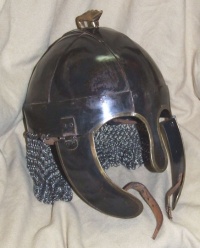Helm: Difference between revisions
No edit summary |
|||
| (23 intermediate revisions by 12 users not shown) | |||
| Line 1: | Line 1: | ||
[[image:saxonhelmet01.jpg|right|200px|thumb|Replica Saxon Helmet.]]The '''helm''' or '''helmet''' is the [[armour]] that covers the head. |
|||
The armour covering the head, a helm needs to be constructed of at least 16 gauge steel to be legal in the SCA for use in heavy or light combat. For further details, consult your kingdom [[combat handbook]]. |
|||
| ⚫ | |||
* [[Roman]] - Covers the top and back of the head with metal flaps covering the ears and part of the cheeks. |
|||
* [[Saxon]] - Covers the top, the back and sides of the head, sometimes extending to cover the cheeks. There may be some nasal protection. The higher the rank, the more ornate the decoration. |
|||
* [[Norman]] - Covers the top of the head and the nose. |
|||
* [[Crusade]]/Early [[Renaissance]] - Enclose the entire head with airholes and slit for eyesight |
|||
* Late [[Renaissance]] - Enclose the entire head with airholes and even smaller slit for eyesight. Shaped more to match the shape of the head. |
|||
General [[soldier]]s used simpler designs than those described above for the higher ranked warriors. |
|||
| ⚫ | |||
The helm may be attached to [[maille|mail]] or a [[gorget]] to protect the neck. A [[coif]] is often worn under the helm. |
|||
==Specific Examples of Helmets== |
|||
*[[spectacle helm]] |
|||
*[[spangen helm]] |
|||
*[[great helm]] |
|||
*[[kettle helm]] |
|||
*[[bascinet]] |
|||
*[[sallet]] |
|||
*[[armet]] |
|||
==Helms in heraldry== |
|||
[[Heraldic helm]]s appear, by heraldic convention, above a [[device]]'s [[shield]] as a signifier of the owner's [[rank]]. Helms can also appear as [[charge]]s within devices. |
|||
==SCA Combat Helms== |
|||
In the [[SCA]], a helm needs to be constructed of at least 16 gauge steel* to be legal for use in [[heavy fighter|heavy]] or [[light fighter|light combat]]. Protection needs to be extended down the back and sides of the neck (therefore strictly period [[Norman]] helms need certain modifications) and the face must be completely covered, if only with a hockey-helmet style grille or [[bar grill]]. This protection must extend down to meet the throat and spinal protection of the [[gorget]]. |
|||
For further details, consult your [[kingdom]]'s [[combat handbook]]. Bars or grilles are to be placed across any openings large enough to admit a 1-inch diameter [[rattan]] weapon. |
|||
Normal helms are not standard in SCA [[fencing]] but head and face protection is still required. Helms can be used provided they meet all the minimum requirements according to the SCA fencing rules. |
|||
*While the Marshal's Handbook states 16 ga, but they specifically state that they mean the original definition of 16 ga. - 0.0625". In modern, commercial ferrous, rolled sheet (iron, steel), 16 ga. is only 0.0595", while non-ferrous sheet still uses the original definition. |
|||
==Reenactment Combat Helms== |
|||
Reenactment helms are styled after historical examples and do not include the bars found on [[SCA]] helmets. |
|||
== External Links == |
|||
* [http://moas.atlantia.sca.org/wsnlinks/index.php?action=displaycat&catid=164 Atlantian A&S Links: Helmets] |
|||
[[category:armour]] |
|||
[[category:helmets]] |
|||
Latest revision as of 14:21, 27 December 2011
The helm or helmet is the armour that covers the head.
There are many different designs of helm through the years. Some general descriptions are:
- Roman - Covers the top and back of the head with metal flaps covering the ears and part of the cheeks.
- Saxon - Covers the top, the back and sides of the head, sometimes extending to cover the cheeks. There may be some nasal protection. The higher the rank, the more ornate the decoration.
- Norman - Covers the top of the head and the nose.
- Crusade/Early Renaissance - Enclose the entire head with airholes and slit for eyesight
- Late Renaissance - Enclose the entire head with airholes and even smaller slit for eyesight. Shaped more to match the shape of the head.
General soldiers used simpler designs than those described above for the higher ranked warriors.
The helm may be attached to mail or a gorget to protect the neck. A coif is often worn under the helm.
Specific Examples of Helmets
Helms in heraldry
Heraldic helms appear, by heraldic convention, above a device's shield as a signifier of the owner's rank. Helms can also appear as charges within devices.
SCA Combat Helms
In the SCA, a helm needs to be constructed of at least 16 gauge steel* to be legal for use in heavy or light combat. Protection needs to be extended down the back and sides of the neck (therefore strictly period Norman helms need certain modifications) and the face must be completely covered, if only with a hockey-helmet style grille or bar grill. This protection must extend down to meet the throat and spinal protection of the gorget.
For further details, consult your kingdom's combat handbook. Bars or grilles are to be placed across any openings large enough to admit a 1-inch diameter rattan weapon.
Normal helms are not standard in SCA fencing but head and face protection is still required. Helms can be used provided they meet all the minimum requirements according to the SCA fencing rules.
- While the Marshal's Handbook states 16 ga, but they specifically state that they mean the original definition of 16 ga. - 0.0625". In modern, commercial ferrous, rolled sheet (iron, steel), 16 ga. is only 0.0595", while non-ferrous sheet still uses the original definition.
Reenactment Combat Helms
Reenactment helms are styled after historical examples and do not include the bars found on SCA helmets.
